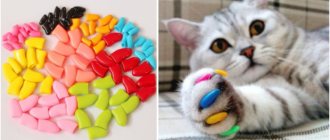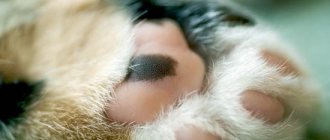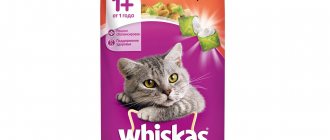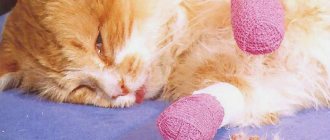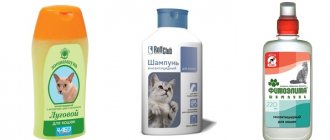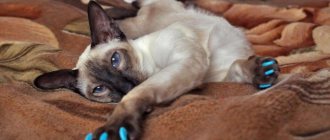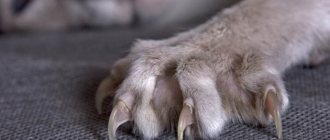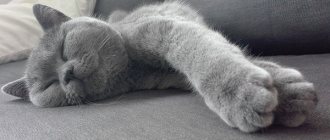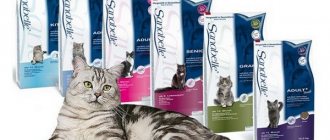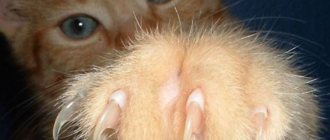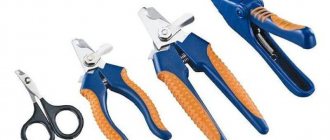What do anti-scratch guards look like and what are they for?
The device looks like a small silicone cap that follows the shape of a cat's claw. The main purpose is to protect walls and furniture from damage.
The cat will not be able to tear up interior items, rip off curtains and climb on eaves.
There are 4 sizes of cat equipment available:
- XS – kittens older than six months;
- S – small animals weighing 2-4 kg;
- M – cats weighing 4-6 kg;
- L – large cats, including Maine Coons, weighing more than 6 kg.
The cap is put on and secured with glue. It is important to choose the right size - then the cat will not experience discomfort when moving and retracting its claws.
To please the aesthetic taste of the owner, anti-scratch products are produced in various colors. You can do any “manicure” on cat claws.
The kit includes 20 pads and hypoallergenic medical glue with instructions on how to glue the devices. Most animals are recommended to glue caps only to their front “active” paws to prevent them from tearing up furniture, climbing on curtains, and scratching while playing.
Anti-scratch guards are only worn on all 4 armor for aggressive cats.
What are anti-scratch guards and why are they needed?
The modern veterinary industry is releasing more and more devices for cats. Anti-scratch products are especially popular.
The idea of creating such an invention belongs to the American veterinarian Toby Wexler, who is categorically against declawing surgery, which spoils the life of an animal.
That's why protective claw covers for cats were invented.
Such inventions have been widely used in the USA and Europe for more than 10 years. Translated from English “soft claws” they mean soft claws. And this is no coincidence, because these are, in essence, soft silicone caps for claws, attached to clipped cat claws using special glue.
These devices are available in different sizes and color variations (yellow, blue, green, orange, pink, etc.). It is the bright color palette that helps determine whether the false claws are in place after gluing.
Also, most cat owners consider silicone products to be excellent fashion accessories that can be matched to the color of the collar. Just look at the photos of the most fashionable cat claws.
Some people make them with their own hands, while others buy special nail guards in pet stores. Cats with such a “manicure” on their paws do not lose their habits and behavior. They are still playing and getting better.
Why do we need silicone claw covers?
There are several factors why you need to buy such devices:
- Ensuring the health safety of household members. Even a small scratch can cause harm to health. After all, cat claws contain microbes that can easily get into an open wound and cause inflammation, and in the worst case, blood poisoning. Scratches are also dangerous for those people who have allergies, poor blood clotting, or immunodeficiency syndrome.
- When there are small children in the house. Babies love to cuddle and carry pets. Not every mustachioed friend will like this behavior of the child, and for the purpose of self-defense he can use his claws, scratching all the delicate skin of the child and thereby “rewarding” him with an infection. Therefore, you simply cannot do without special caps for cat claws.
- If the cat cannot be re-educated. Pets can be not only affectionate, but also aggressive. They can attack both offenders and their owners and guests. There are also often situations when a furry friend, when another pet appears in the house, experiences jealousy and tries to harm him in any way. In this case, special covers for the claws will be able to somehow pacify the cat’s harmful disposition.
- Protection of furniture, wallpaper, curtains and other interior items. Pussies love to sharpen their claws on the sofa, armchairs and wallpaper. They also simply love to climb curtains, leaving behind noticeable holes and puffs. If you value your favorite interior items, you simply need to purchase anti-scratch products.
Advantages and disadvantages
Compared to trimming or complete removal of claws, anti-scratch treatments have a great advantage:
- Do not harm the animal. Cats freely retract and release their claws, move, and remain playful.
- Makes caring for your cat easier. You can bathe or give medications without the risk of being scratched.
- Preserve the interior from destruction. There will be no torn furniture, wallpaper, or torn curtains.
- Do not disturb the natural growth of the claw. Gradually, the top layer of the horny plate peels off, and the claw is renewed.
But cats feel glued anti-scratch pads as a foreign body, so even the calmest animals experience stress and discomfort for several days. Due to the fact that the cat has nothing to cling to, it experiences inconvenience:
- when jumping onto high surfaces;
- when braking while running;
- during hygienic procedures (they cannot scratch themselves fully).
A cat with anti-scratch protection is defenseless on the street. In escaping, he will not be able to climb a tree or defend himself from an attack.
Another unpleasant property of anti-scratch caps is that during active movements (walking, digging a tray), the animal makes unpleasant clicking or creaking sounds.
Before you stick on anti-scratch pads, you should weigh all the pros and cons of the pads and decide whether the animal needs them.
What do veterinarians think?
As numerous reviews from cat owners say, anti-scratch products are an excellent tool for protecting furniture and health. But, judging by the conversations of many veterinarians, these devices bring discomfort to the animal, limiting its cat instincts. After all, after sticking on the protective caps, it will be difficult for the cat to jump, move fully and sharpen its claws.
But nature itself provides for all this. And if you impose bans on the cat’s instinct, then all this can negatively affect the animal’s psyche.
But if you choose between surgery and gluing claws, it is better to opt for the second option, since silicone caps do not injure the animal as much as surgery.
Which anti-scratch glue is best to choose?
The best option would be the glue that comes with the caps. This product sticks well and is safe for the cat’s body.
If the adhesive has run out and there are still caps left, you can purchase medical hypoallergenic adhesive based on cyanoacrylates. They are sold in medical equipment stores and veterinary pharmacies.
Gluing onto Supermoment and other household quick-setting building mixtures is prohibited. When using this glue, cats often have allergies. Under the pads, the claws can crack due to aggressive chemical elements.
How to trim a cat's claws
In addition to the standard nail clippers, which are the first to be found in every pet store, there are several other tools for cat “pedicure”. List of products used for trimming nails
Table 2. Tools for cat pedicure
Scissors | A classic and budget option, which cat owners most often limit themselves to. Manipulation with scissors does not cause any particular difficulties; their main disadvantage is the thickness of the blade, which increases the likelihood of capturing the sensitive part of the claw, equipped with blood vessels. |
Wire cutters | This option differs from scissors by a special notch in the blades that adapts to the shape of a cat’s claw. With the help of nippers, it is much more difficult to make a mistake and injure a cat’s claw, due to their ergonomics and specialization for cats. |
Guillotine trimmer | This specific tool is recommended for those cat owners who have already mastered the previous options and feel confident. The sharp blade of the trimmer extends when you press the handle and easily trims the tip of your pet's nail |
Nail file | This remedy is well known to every person, but it is used least often on animals. However, it is the file that allows you to complete the work started with a nail clipper. In a cat pedicure, just like in a human pedicure, uneven corners may remain, which are smoothed out thanks to filing |
How to glue correctly: step-by-step instructions
It is better to carry out the procedure together: one holds and calms the cat, and the other sticks on the caps. Gluing consists of several stages:
- Preparing the claw. Before gluing, the tips of the claws are ground down by 1-2 mm, and the surface is gently sanded. This will allow the pads to be secured more securely.
- Fitting. First, an anti-scratch guard is put on the claw without glue. When the size is selected correctly, it fits tightly, not reaching the sinus of the claw by 2-3 mm. If the anti-scratch length is longer, then it can be cut to the required size from the socket side.
- Fill the cap 1/3 full with glue, quickly put it on the claw all the way, squeezing it lightly on the sides. Hold for 5 seconds. Before pulling the cap on, you need to lightly press on the cat's paw so that the claws extend to their full length.
- After installing the anti-scratch device, hold the cat in your hands for 10-15 minutes so that the adhesive composition polymerizes, ensuring a strong attachment of the attachments.
It is important to ensure that the glue does not get on the cat's skin. If this happens, the skin will tighten as the claw grows, causing pain to the animal. The first sign is that the pet is lethargic and avoids walking and playing.
If you have no experience with gluing, then the procedure can be carried out in several stages: after one paw is treated, give the cat a little rest from the stress it has experienced, and then work on the other.
Cost of trimming cat claws in Moscow
To properly trim a cat's claws, you need to have some basic knowledge and skills. However, you can completely avoid the risk of injury during the procedure by entrusting your pet to a professional veterinarian in the clinic.
Nail trimming on 1 paw 200 rub.
Full nail trim RUR 300
109469, Moscow, st. Bratislavskaya, 22 (up the ramp next to Dodo Pizza)
daily 10:00 – 22:00
We accept cards:
We are in social networks:
© 2021, “GOS-VET” Veterinary clinic in Maryino All rights reserved
If a cat begins to scratch and tear things, this is not a behavior problem, but a natural process of wearing down its claws. Trimming the horn plates is one of the common grooming procedures. However, not all owners know how to trim a cat’s claws and do it correctly at home.
When and how to change anti-scratch pads
The maximum service life of the caps is one and a half to two months. During this period, the claw is completely renewed, so the lining itself will come off along with dead tissue.
Some cats do not tolerate foreign bodies on their claws, so the caps may end up in the stomach. If this happens, there is no need to worry - silicone caps are harmless and will leave the cat's body naturally.
If a cat reacts nervously to soft pads, constantly tearing off the anti-scratch pads, then there is no need to glue them. It’s better to come up with another way to protect yourself from cat claws.
How often should nail pads be changed?
Anti-claws for cats have a limited service life, after which they must be removed. If all gluing rules are followed, the pads stay on the animal’s claws for about two months. After this time, the caps gradually begin to peel off and fall off, due to the natural growth process.
If false nails do not fall off on their own, do not panic, just cut them off with scissors. During the procedure, it is important to be careful and attentive so as not to damage the cat's paw or claw.
How anti-scratch pads fall off on their own
Important! If there is a small part of a cat's claw inside the protective cap, this is a normal process of peeling off the dead layer of the cornea.
When not to use
Claw caps are intended for adult active cats living in an apartment without self-walking. It is not recommended to glue the device in the following cases:
- Kitten up to 6 months. Small kittens have soft claws, so they do not cause much damage to interior items.
- Older cats that don't sharpen their claws. There is no point in gluing anti-scratch pads.
- Cats walking on the street. Cat claws are needed to freely overcome obstacles, climb trees, or defend themselves in case of danger.
Before gluing soft pads, you need to analyze how they will affect the cat’s life and whether they will harm its safety. If there is a risk that your pet will end up outside, then you should look for another way to protect furniture from cat claws.
conclusions
For the procedure of trimming a cat’s claws to be successful, you do not need:
- Try to cut everything at once. It is better to do this in several approaches.
- Carry out manipulations when the owner himself is not sure that he can cope or the cat is too excited.
- If the animal resists, force it to sit still and swear.
Any care activity should not cause negative emotions in the animal.
Do I need to trim my cat's claws?
Should you trim your cat's claws or not? On the Internet, supporters and opponents of the procedure break their spears, but everyone decides for themselves and I think a lot depends not even on how sorry you are for your great-grandmother’s antique chest of drawers or wallpaper. And it depends on how close a friendly relationship you have established with your animal and how many clawed animals live in the same apartment.
Our first acquaintance with scissors for trimming claws took place about a month after the Chupacabra arrived at its new home. The furniture was somehow indifferent; the cat liked wires more. But more than wires, he loved to settle down in my hair on the pillow and begin to “claw” his mistress’s head with special tenderness. When it became clear that scalping could not be avoided, we went to a veterinary pharmacy and bought special nail clippers - a guillotine trimmer.
Mmyaaaaaaaaaaaaaaaaaaaaaaaaaaaaaaaaaaaaaaaaaaaaaaaaaaaaaaaaaaaaaaaaaaaaaaaaaaaaaaaaaaaaaaaaaaaaking on on the owner's lap, belly up. This loud, mournful “Mryaayuu” accompanied the entire grooming procedure, while the cat was coaxed and kissed on each paw, so that no one else was hurt, although one of the paws was catastrophically close to the owner’s neck.
With age, the Chupacabra became more relaxed about the procedure for trimming its claws, and I began to trim its claws correctly - after all, you can’t just cut off the tips of a cat’s claws, you need to do it at the right angle and without going beyond the norm.
At the same time, we have a scratching post in the house. But a cat doesn’t always only need it for nail hygiene, and it’s the haircut that saves us from unnecessary injuries - after all, we also have a second cat with special needs.
Although, even with their claws trimmed, my cats pulled up two duvet covers into rags - that’s just their hobby!
A cat needs claws when it lives in the wild. A domestic cat climbs trees less and is generally less mobile, so its claws do not wear down and often grow longer than necessary. And then the cat turns into a Cheburashka - constantly clinging to everything with too long claws. Which can lead to injury to the animal, which no one would want.
It is important to understand that trimming a cat’s claws does not hurt. If you do it correctly and carefully, without touching the nerve endings. And she may hiss and be indignant out of fear of a new, unfamiliar object in your hands.
The need for this procedure is determined by the owner. All domestic cats can have their nails trimmed; it will not harm them in any way. Unless it's a cat that lives outside, it needs its claws for protection. There is an opinion that a cat that is accustomed to clinging with its claws when jumping may be injured if its claws are trimmed. This is possible in very rare cases, if the cat is used to climbing on curtains, for example. But this does not apply to animals that were taught to trim their nails as children.
It is necessary to trim the nails of older animals if they have a problem with ingrown claws, they do not file down their claws properly and they grow too long and can pierce the pads of their paws. This causes pain and discomfort for the cat and can also lead to suppuration.
What tools can you use to trim a cat's claws?
The choice of tool for trimming a cat’s claws depends on the capabilities and skillful hands of its owner. Some people use regular nail scissors or nail clippers; we bought special scissors with a hole for claws - a guillotine trimmer. There is essentially no difference, it’s just that it’s probably more convenient to cut with special scissors.
There is also an electric cat claw trimmer, somewhat reminiscent of a mechanism for a hardware manicure. I don’t know how your cat will react to this - mine don’t like buzzing objects and, I’m afraid, it would be completely impossible to hold it in your hands while trimming its claws with such a device.
Some websites now sell special restraining overalls for particularly violent ones. If your cat absolutely refuses to part with the scratches peacefully, perhaps such a device can make your life easier
FAQ
Some cat owners are in no hurry to put anti-scratch pads on their pets for fear of harming the cat's health. In some cases, fears are unfounded.
Do pads affect nail growth?
No, that's not happening. The habitual change of claw occurs in a cat within 1.5-2 months, then the silicone device itself comes off with the upper stratum corneum of the old claw. In active, playful cats, the anti-scratch pads may come off earlier due to the fact that movement creates vibration, which reduces the fixing properties of the glue.
From what age can it be used?
There are no strict age restrictions, but veterinarians recommend gluing anti-scratch pads at 6 months or later. Small kittens have soft claws that hardly damage the interior and are renewed much faster due to the growth of their paws.
Therefore, it makes no sense to glue protection to cat babies up to six months.
Is it safe for your pet?
When using special glue there is no danger to the cat's health. The procedure is painless, and the discomfort after fixing the anti-scratch goes away within a few days.
Gluing is only allowed on healthy cats with intact claws. Wounded paws or cracks in the claw are a contraindication for silicone pads. You need to wait until the pet recovers and then glue the caps.
Why do my cat's claws peel?
The separation of the keratinized layer of the epidermis is characteristic equally of both humans and cats. However, due to the fact that cats use their claws much more actively, their deterioration affects the cat’s well-being and mood.
With peeling claws, the cat may show resistance when the owner tries to take the paw and look at the claw, and may show increased aggression due to the pain experienced. In addition, peeling claws are fraught with damage and even tearing out, so treating this problem with indifference is a big mistake.
Splitting claws cause significant discomfort to their owners.
Among the reasons why claws become separated are the following:
- Incorrect/lack of trimming. Even with frequent care of your pet's claws, there is a risk of their delamination. As already mentioned, any carelessly trimmed claw tends to cling and “tear.” A file can help in this situation, as it will bring the cat’s claw to the most streamlined shape. The lack of a haircut as such leads the cat to long, breaking off claws, which sooner or later will certainly begin to break and split;
In the absence of proper care, even the healthiest and strongest claws begin to peel.
- Lack of vitamins. Calcium and vitamins of group D are responsible for the strength of the keratinized layer of the epidermis, in a desperate search for which cats begin to chew their claws. In such cases, it would be a good idea to take your pet to the veterinarian and ask him about possible vitamin supplements, or foods rich in substances in which the pet is lacking. Biotin is often prescribed to cats with dehiscent claws, which should be taken twice a year. It replenishes the lack of calcium and allows you to restore the epidermis;
Vitamins allow the cat to keep his body in good shape
- Rapid growth of claws. Due to malfunctions of the thyroid gland, cats sometimes experience excessively rapid growth of their claws, which literally does not allow the owner to keep up with them with a nail clipper. Treatment for this disease lies in the veterinarian’s office, which will identify the causes of gland dysfunction and prescribe appropriate treatment with an accompanying vitamin complex for the general strengthening of the body and claws in particular.
Claw separation is often observed in nursing cats.
Claw separation is often found in pregnant and lactating cats due to the fact that she wastes all her physiological resources on feeding her offspring. In such cases, the above-mentioned calcium deficiency can be easily compensated with the help of vitamin supplements and specialized feed. As a rule, even without vitamin interventions, when kittens grow up, the cat’s claws return to their previous healthy state.
Veterinarian's opinion
A cat should sharpen its claws - this is its natural instinct. Therefore, gluing silicone pads causes serious stress even for the most phlegmatic cats. Adaptation to the new state lasts from several days to several weeks. Veterinarians note that at this time cats experience:
- Tactile discomfort. The cat loses the ability to fully feel the surface with its paws, tries to jump low, and walks carefully.
- Increased injury rate. After gluing anti-scratch protection, some cats do not immediately adapt to the new condition, try to jump on high surfaces, and run quickly. The inability to grab hold of the claws leads to the animal falling and getting injured.
- Impossibility of self-defense. If a pet is walking along the street, then the pads on its paws mean that it will not be able to protect itself from attacks by dogs or stray cats, and will not be able to climb a fence or tree to save its life.
Veterinarians recommend carefully considering whether it is worth gluing anti-scratch products.
But in general, veterinarians have a positive attitude towards silicone claw overlays, considering anti-scratching a less traumatic method compared to claw trimming or onychectomy, when the claw is removed along with the last phalanx of the cat's toe. The caps are put on temporarily, the animal’s claws are not damaged, and after the stratum corneum is renewed, they come off completely, allowing the cat to return to her previous life and use her claws again.
Gluing anti-scratch pads is easy. All you need to do is select the right size of the product, taking into account the weight of the cat, prepare the claws, and then quickly put on the pads. But despite the fact that the procedure is harmless to the cat’s health, before gluing, you need to assess the life characteristics and age of your pet. In some cases, anti-scratch pads can cause injury.
How to put on and take off anti-scratch boots correctly?
Before gluing the caps, you should measure them. All cats' claws are different and the size of the products does not always correspond to them. In this case, they can be changed at the store where you bought them. When you try on the caps, pay attention to how they fit on the claws. Products should fit tightly to the claws, they should not slip off. The distance of products from the base should be 3-5 mm.
If the caps are too long, then they can be trimmed from the hole side with small scissors.
How to properly wear anti-scratch guards for your pet?
It's very simple: first prepare the caps and glue, then provide the cat with a suitable environment. It is best to sit the animal on your lap and calm it down with affection and something tasty. Then you can begin the process itself.
If the cat's claws are long enough, then they should first be cut with special scissors, as you do all the time. And it is advisable to additionally treat the surface with a nail file. This is necessary for effective gluing of the overlay.
Don't forget to disinfect your claws with an antiseptic (alcohol, vodka or miramistin) and degrease them with nail polish remover. After this, squeeze a little glue (one drop) into the anti-scratch pad and lightly press the pad of the paw with your fingers, causing the claw to come out.
Place the product on the claw and lightly pinch it from the sides for secure fixation. This procedure will not take you much time. But after sticking all the claws on, it is recommended to hold the cat on your lap for a few more minutes. During this time, you can stroke and caress him. Then you can let him go.
This video shows the entire procedure for putting silicone caps on cat claws:
At first, the cat will not completely accept such “nails” and may even try to tear them off. This is an absolutely normal reaction to the presence of a foreign body.
If the cover comes off, you can glue a new one in its place.
Silicone tips usually last about a month. And if you want to remove them, then there is no need to do this, because they themselves fall off with a layer of keratinized cells.
Anti-scratch pads should be changed as soon as the renewal of the upper stratum corneum of the claw begins. This usually happens once every two months.
By the way, you can put the caps on all four paws, or only on the front ones.
If you are unable to “shoe” your cat because he scratches and bites, it is better to seek help from a veterinarian or groomer.
